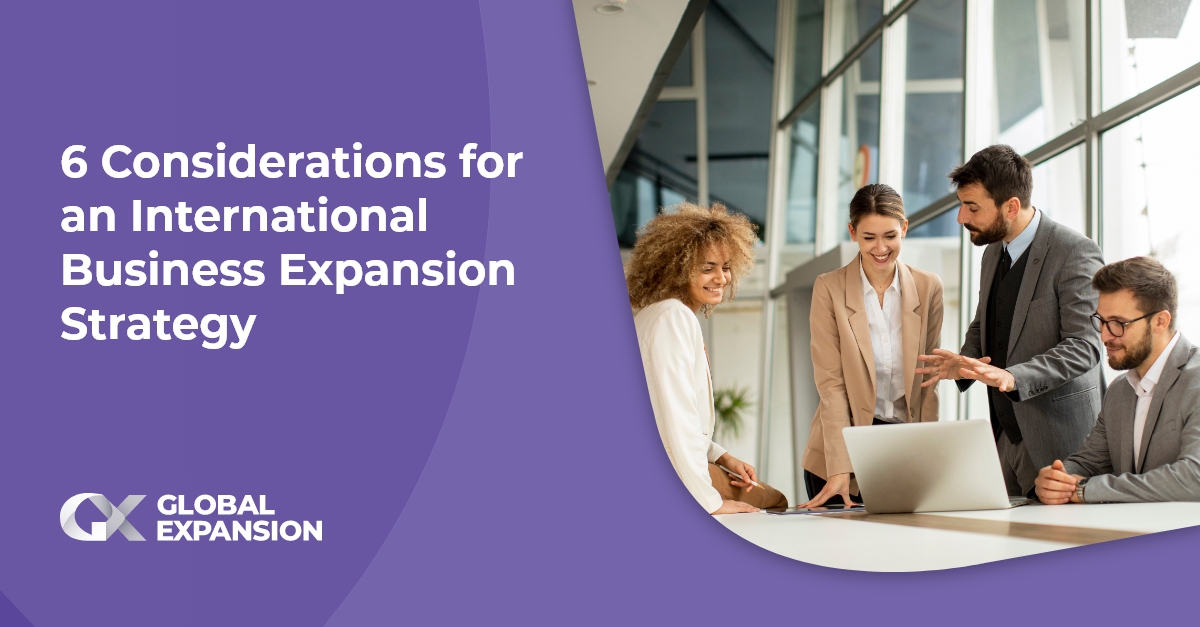When a business has grown to capacity within its home nation, it could be time to look into a new international market for that next stage of progression. Global expansion is a great way for companies to diversify and broaden their business model, venture into new and emerging markets, and explore the possibilities of international talent pools.
What is international market expansion?
International expansion, in the simplest of terms, is the transition from a local business to a global company through an expansion strategy that enters a new country and market. Not only does this involve seeking new business opportunities abroad, but it also includes the operational growth of the business itself — whether it’s establishing new offices in the target country, finding a local partner or recruiting local talent.
It’s important to approach global growth with a strategic mindset to be successful. Factors to consider include the reasons for expansion, what target countries to expand into, and how to go about achieving a successful expansion that remains compliant with local laws.
- Increase revenue
When domestic market expansion has reached its peak, the only logical next step is to look overseas. Global expansion opens up new revenue streams and excellent opportunities to maintain consistent growth. - Enter new markets
International growth allows businesses to find new markets and opportunities. This is especially true for companies operating in a saturated local market, where their services or products may have more room to develop and dominate in an alternative location. - Find more top talent
Hiring international talent has many advantages, including language skills and varied educational backgrounds. International expansion also allows companies to employ local talent who have the expertise to communicate and serve clients in their local market. - Expand your customer base and offering
With a much broader customer base, you can generate more business and increase sales. Furthermore, a new customer base in a new country opens up opportunities to invest and introduce new products and services in a location where it won’t impact core local revenue. - Cost Savings
Operational costs in different and emerging markets can be much more affordable. Whether it’s manufacturing, procurement, distribution, or talent acquisition, global growth has the potential to make significant reductions to overheads.
Whatever your reason for exploring international expansion, and whichever country you’re looking into, an expansion strategy needs to be developed to successfully and compliantly enter that country. But what expansion methods are there?
Reasons for international expansion
There are many reasons an organization might be considering international expansion as the next step to growth. Here are five of the most common:
Methods of international expansion
There are many international expansion strategies to choose from when pursuing growth into foreign territories, each with benefits, pitfalls and considerations. Some countries have unique and sometimes difficult legislation in place to protect their markets, while others are very open in an effort to attract development. Understanding the different types of international expansion strategies will help determine what approach to take to ensure the greatest likelihood of success for your business.
Here are three of the most common strategies to consider, including their pros and cons:
Licensing Arrangements
Licensing arrangements allow other companies to use your intellectual property, but there are stipulations surrounding what these use cases can be. For example, a licensing arrangement is either exclusive to a company, non-exclusive or specifically exclusive to a location or circumstance.
It’s a relatively simple way to capitalize on a foreign market and usually means you’re getting access to pre-existing supply chains and distribution methods. Licensing arrangements are found in many places, such as franchising (McDonald’s is a famous proponent of franchising) and private labeling. This is where your product is sold under the name of another company.
When it comes to licensing arrangements, the amount of legislation involved can be off-putting. Additionally, putting your product to market by yourself may seem like a more attractive option, especially when your business wants to increase brand reputation in an area. Relying on a local partner to maintain your brand identity can be a daunting prospect.
It’s pivotal to find a licensor that is the right choice for you, and you don’t want its reputation downgraded through association with an unpopular brand name.
Furthermore, licensing arrangements apply differently across the world. For example, in the UK, the Intellectual Property Office stipulates that companies must obtain a ‘license of right’ with their product patent, which means that other entities are now able to license those products. If you’re a UK company looking to do this, you’d have to fill out Patents Form 28 and then have potential licensors approach you directly.
This is just one example, as each country will have its own approach that needs to be understood before making any progress.
Pros
- Quick market access.
- Leveraging licensee experience and market position.
- Increased revenue and reach from new markets.
- IP licensing may create collaboration opportunities for further innovation.
Cons
- Cross-border IP legislation can be complex.
- Legal fees can be high.
- Risk of breach by third party.
Mergers and Acquisitions
It’s a common phrase with a more common meaning, describing the state where one organization can either ‘merge with’ or ‘acquire’ another. Think of Exxon Mobil (formerly Exxon and Mobil respectively), or when Disney acquired Pixar or Marvel.
Mergers and acquisitions (M&As) are greatly beneficial when done successfully, providing you with the full infrastructure capabilities of a separate organization already set up and able to function in your target country. While the preparation can take years, once the proverbial papers have gone through, you’re good to go.
Because of the time it takes for these processes to be completed, they can be very expensive. Similarly, there's the issue of exchange and interest rates. If the acquiring firm is from a country with a weaker currency, the process can be even more expensive. However, the opposite is true for companies from countries with stronger currencies.
There’s also the issue of regulatory statutes. Like with licensing arrangements, these vary from country to country. For example, in the US foreign companies are not allowed to own more than 25% of an American airline.
There are a key number of legislative propositions that apply to both foreign countries looking to merge with or acquire other organizations on American soil. For example, Section 7 of the Clayton Act provides that no individual or company can acquire the whole stock, share capital or assets of another “where in any line of commerce . . . in any section of the country, the effect of such acquisition may be substantially to lessen competition or tend to create a monopoly.”
The Hart-Scott-Rodino Antitrust Improvements Act of 1976 (the “HSR Act”) can be another significant hurdle to overcome. The HSR Act maintains that M&As cannot be completed until the involved organizations have filed the case with the Federal Trade Commission (FTC) and the Department of Justice. These agencies then determine whether the transaction will adversely affect US commerce under antitrust law.
There’s also the Exon-Florio Amendment to contend with. Although, it’s unlikely you’d come under any scrutiny through this amendment, as it pertains to stopping foreign businesses acquiring American businesses if they pose a threat to national security.
Mergers and acquisitions are a high-risk, high-reward expansion method and should be approached with a great amount of care and consideration.
Pros
- Access to a complete distribution infrastructure.
- New talent and innovation pools.
- Potential for stronger brand identity.
Cons
- Resource intensive, in terms of both time and money.
- High failure rate, with 40% to 60% of M&As failing to increase market value.
- Risk of culture clash.
Entity Set-up, PEO and EOR
Entity set-up is not so much a set expansion method in itself, but rather a means to ensure your expansion goes without a hitch. This is where an organization creates an entity — usually a physical premises with a registered business — in another country. While this is a common expansion method and often successful, it does present a significant challenge, especially for first-timers.
For example, the set-up costs are invariably large. Premises, expatriation, tax obligations, utilities, security, even cleaning — these will all take a chunk out of your expansion budget. On the other hand, working with an international Professional Employer Organization (PEO) can help you reduce these costs and keep your expansion process running smoothly.
An international PEO can act as the Employer of Record (EOR) for expansion, helping to recruit overseas talent, arranging payroll and deducting taxes at source. They can also help prepare you for the specific financial, legal and cultural differences you and your company might experience during expansion.
Pros
- Fast speed-to-market.
- Bespoke cultural knowledge and market research.
- Full compliance guaranteed during expansion.
- Background screening.
- 24/7 support.
- In-country HR capabilities.
- Technological advantage through real-time data and communications.
Cons
- Represent an added cost to your expansion.
- Not a guarantee that the entire expansion will be a success (although this is mainly due to environmental factors).
These are just three international expansion strategies that are available to you. If you’re looking for more information on expansion, as well as strategies and growth options, our guide provides a more comprehensive overview and insights into how to go about planning your international business expansion.
International growth with Global Expansion
Developing a global expansion strategy is no easy feat. It’s a complex and costly process — even more so if you get it wrong or miss something vital — which makes it seem all the more daunting. The complexities of expansion, globalization, and international regulations may seem like a never-ending gordian knot, but they’re not insurmountable. Through the right preparation and collaboration, you could be seeing your business thrive in another territory sooner than you think.
Visit our Thought Leadership page and download our guide to discover more helpful advice on how to take advantage of the global market and take your business to the next level.
Subscribe to our blog
Receive the latest GX blog posts and updates in your inbox.





